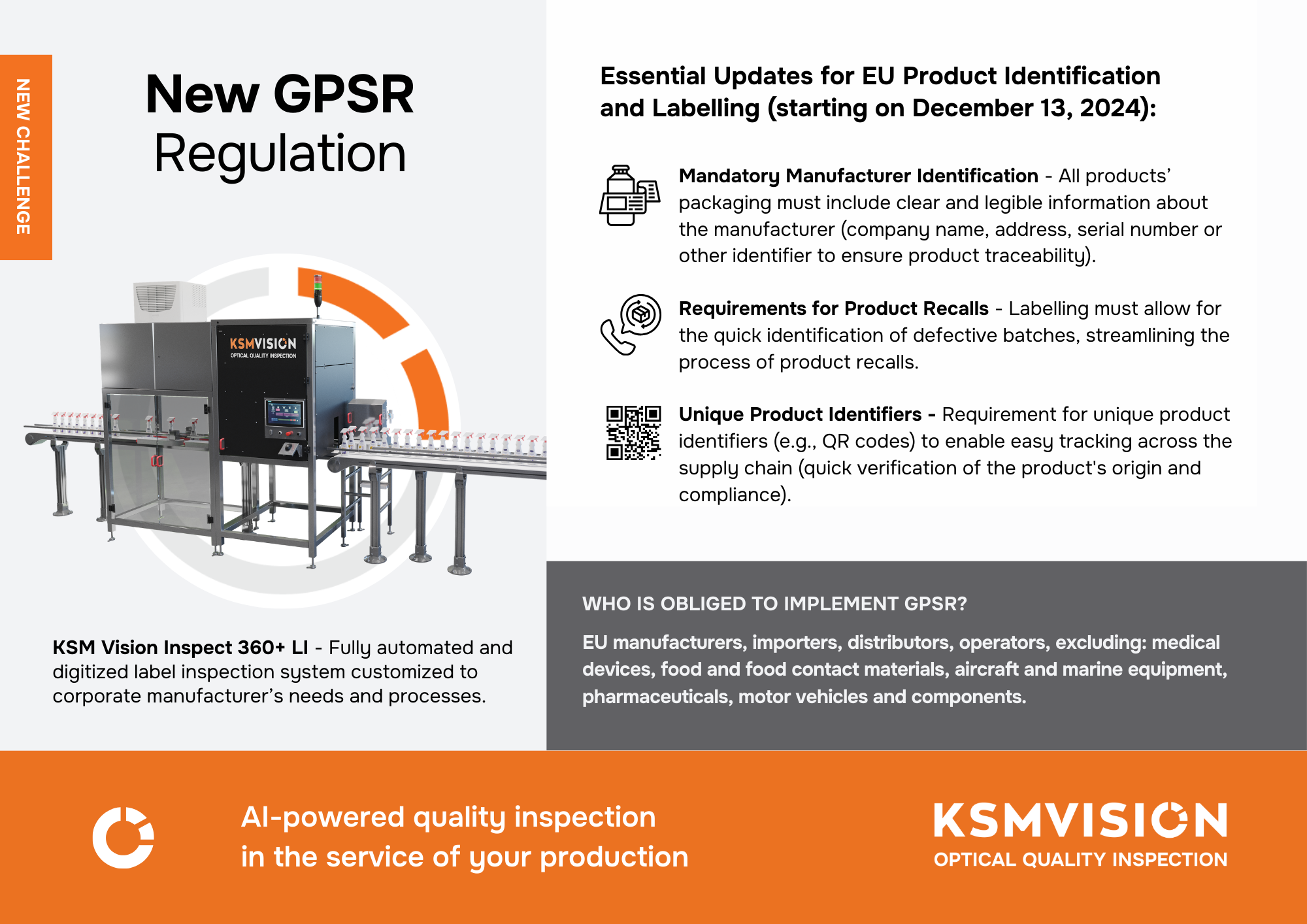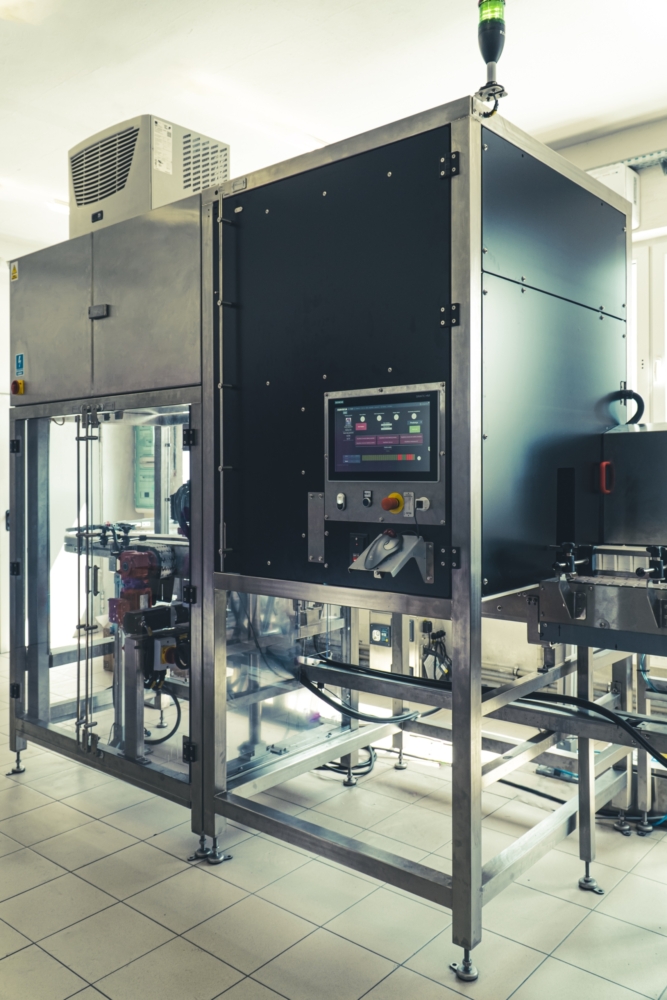General Product Safety Regulation (GPSR) – Key Changes for Product Identification and Labelling Regulations

From December 13, 2024 the new General Product Safety Regulation (GPSR) introduces significant changes for manufacturers in the EU regarding product identification and labelling. Learn key changes for Product Identification and Labelling resulting from GPSR.
- What changes does General Product Safety Regulation (GPSR) introduce for the manufacturers?
- Why is GSPR important?
- Who is Obliged to Implement GPSR?
- Are all EU manufacturers obliged to comply with General Product Safety Regulation?
- How can vision systems support GSPR compliance?
- What brands offer automated label inspection systems?
- Fully-automated and flexible automated machine vision system far above smart cameras regardless the size and format of your product?
- Summary
What changes does General Product Safety Regulation (GPSR) introduce for the manufacturers?
The new General Product Safety Regulation (GPSR) introduces significant changes for manufacturers in the EU regarding product identification and labelling. Here are the essential requirements that manufacturers need to comply with in view of new regulations:
- Mandatory Manufacturer Identification: All products (or their packaging) must include clear and legible information about the manufacturer, such as: Company name, Contact address, Serial number or another identifier to ensure product traceability.
- Unique Product Identifiers: The regulation introduces a requirement to use unique product identifiers (e.g., QR codes) to enable easy tracking across the supply chain. This will allow consumers and authorities to quickly verify the product’s origin and compliance.
- Labels in Local Languages: Products sold in the EU must be labelled in the official language(s) of the country where they are marketed. This includes user instructions and safety warnings.
- Compliance Markings: If the product falls under specific regulations, the labelling must clearly indicate compliance with relevant standards (e.g., CE marking where applicable).
- Long-Term Document Retention: Manufacturers are required to retain technical documentation and declarations of conformity for at least 10 years after the product is placed on the market.
- Requirements for Product Recalls: Labelling must allow for the quick identification of defective batches, streamlining the process of product recalls when necessary.
GPSR changes aim to enhance consumer safety and market transparency. GPSR applies starting 13 December 2024.

Why is GSPR important?
From the customers’ perspective, the GPSR is crucial for ensuring consumer safety in the EU. It modernizes rules to address new risks, improves product traceability, and strengthens market surveillance. By setting clear safety, labelling, and recall requirements, it enhances transparency, boosts consumer confidence, and creates a level playing field for manufacturers.
For the manufacturers, GPSR is especially important from the legal perspective. Failure in GPSR compliance can lead to serious consequences for manufacturers, including:
- Product Recalls: Non-compliant or unsafe products may be forcibly removed from the market, leading to financial losses and damaged reputation.
- Fines and Penalties: Authorities can impose significant financial penalties, which vary by Member State but are designed to deter non-compliance.
- Legal Liability: Manufacturers may face lawsuits from consumers or other parties harmed by unsafe products.
- Market Restrictions: Products may be banned or restricted from entering the EU market, impacting sales and supply chains.
- Reputational Damage: Non-compliance can erode customer trust and tarnish the company’s brand image, affecting future business opportunities.
- Increased Scrutiny: Repeated violations can lead to heightened monitoring by market surveillance authorities, increasing operational burdens.
Complying with GPSR is essential to avoid these risks and ensure long-term business success.

Who is Obliged to Implement GPSR?
The GPSR is a European Union (EU) regulation, and it is the responsibility of the European Commission to propose and implement such regulations. However, the enforcement and compliance of GPSR fall on various stakeholders:
- Manufacturers: They must ensure that products placed on the EU market comply with the new safety, labelling, and identification requirements. Manufactures are also responsible for product traceability, monitoring safety after products are sold, and cooperating with market surveillance authorities.
- Importers: Must verify that non-EU products entering the EU comply with GPSR requirements, including proper labelling, documentation, and safety standards.
- Distributors: Must ensure that products they sell meet GPSR standards, including proper identification and compliance with safety requirements.
- Market Surveillance Authorities (MSAs): EU Member States are responsible for designating market surveillance authorities to monitor compliance and enforce GPSR rules. MSAs have the power to inspect, test products, and impose penalties for non-compliance.
- EU Member States: Must transpose the regulation into their national legal frameworks (if applicable) and allocate resources for effective market surveillance and enforcement.
- Economic Operators (e.g., authorized representatives in the EU): For non-EU manufacturers, authorized representatives based in the EU are often required to ensure compliance with GPSR on behalf of the manufacturer.
GPSR is binding on all relevant stakeholders operating within the EU market, ensuring a uniform safety standard across Member States.
Are all EU manufacturers obliged to comply with General Product Safety Regulation?
The new GPSR applies to products manufactured in the EU. However, not all products are covered by the GPSR. The regulation does not apply to the below products.
Products Excluded from GPSR:
- Products subject to specific safety regulations, such as:
- Medical devices,
- Food and food contact materials,
- Pharmaceuticals,
- Motor vehicles and their components,
- Aircraft and marine equipment.
- Second-hand products supplied as antiques or for repair purposes (if clearly stated).

How can vision systems support GSPR compliance?
Automated machine vision systems offering label inspection can support compliance with GPSR by:
- Ensuring accurate labelling: Verifying that product labels include mandatory information, such as manufacturer details, unique identifiers, and compliance markings.
- Tracking and traceability: Scanning and validating unique product identifiers (e.g., QR codes) to ensure seamless traceability across the supply chain.
- Quality control: Detecting defects or non-conformities in real-time, ensuring only compliant products reach the market.
- Recall efficiency: Facilitating batch identification for quick and effective recalls if needed.
Such systems enhance compliance, reduce errors, and improve efficiency in meeting regulatory requirements.
What brands offer automated label inspection systems?
Some well-known brands and solutions for label inspection systems are:
- Cognex – Known for its powerful In-Sight Vision Systems and DataMan barcode readers, Cognex offers advanced label inspection, OCR, and barcode validation solutions.
- SICK – Their LabelChecker systems specialize in label content verification, including text, barcodes, and layout accuracy.
- Mettler-Toledo – Offers inspection systems that integrate label checking with product quality control, ensuring compliance for industries like food and pharmaceuticals.
- Omron – Provides vision systems, such as FH Series Vision Controllers, for label verification and quality assurance.
- Keyence – Known for high-speed and accurate vision systems, including the IV Series for label inspection and code reading.
- AVT (Advanced Vision Technology) – Focused on print and label inspection, their solutions are widely used in packaging and labeling industries for inline quality assurance.
- Datalogic – Offers solutions like Matrix and AV Series scanners for label verification and barcode reading.
- KSM Vision – Goes far above smart camera solutions of the competitors, combining innovative optical systems with advanced automation, electronics and dedicated software based on neural networks to deliver the most innovative and flexible automated vision quality control solutions. The flexibility of neural networks makes it possible to train AI models and adapt the vision system to changing production requirements (e.g. new product formats, new types of defects, other processes).

Fully-automated and flexible automated machine vision system far above smart cameras regardless the size and format of your product?
A perfect example of such is fully-automated and digitized Inspect 360+ LI machine vision system by KSM Vision. Inspect 360+ LI can help manufacturers comply with GPSR and avoid non-compliance risks by providing:
- Automated Label Verification: Ensures that mandatory manufacturer details (name, address, identifiers) and compliance markings (e.g., CE) are present and legible on each product.
- Real-Time Quality Control: Detects defects, incomplete labels, or missing safety warnings, ensuring that only compliant products leave the production line.
- Product Traceability: Scans and verifies unique product identifiers, like QR codes, to support traceability across the supply chain, enabling quick response to product recalls if needed.
- Batch Tracking for Recalls: Facilitates precise identification of defective batches, streamlining the recall process and minimizing impact.
- Error Reduction: Minimizes human error in inspections through AI-driven automation, improving compliance consistency.
- Label Language Verification: This capability ensures compliance with critical requirement under GPSR, preventing costly rework, recalls, or penalties:
- Language Detection: The system can identify and verify that labels, user instructions, and safety warnings are printed in the correct local languages required for the target market.
- OCR Technology: Using Optical Character Recognition, it can read and compare label text against pre-approved templates or databases to detect incorrect or missing translations.
- Real-Time Alerts: Flags errors, such as incomplete language sets or incorrect translations, immediately during the production process.
With its advanced vision and AI technology, Inspect 360+ LI helps manufacturers in industries like i.a. woodworking, construction materials’ production, or FMCG can maintain high compliance standards, avoid penalties, and build trust with customers.
Summary
The General Product Safety Regulation (GPSR), effective from 13 December 2024, modernizes EU product safety laws to address new risks and market realities. It replaces the outdated 2001 directive, introducing stricter requirements for manufacturers, importers, and distributors.
Key changes include:
- Mandatory manufacturer identification (name, address, serial numbers).
- Unique product identifiers for better traceability (e.g., QR codes).
- Local language labelling for safety and usability.
- Compliance markings like CE where applicable.
- Enhanced recall processes and batch identification.
- 10-year documentation retention for technical files.
Non-compliance can lead to recalls, fines, market bans, and reputational damage. Advanced tools, like vision systems, can help ensure compliance through automated label verification, language checks, and product tracking.
GPSR aims to strengthen consumer safety, build trust, and ensure a fair market for all stakeholders.

